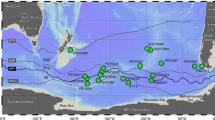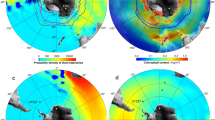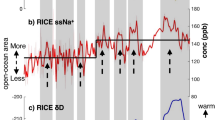Abstract
Dust can affect the radiative balance of the atmosphere by absorbing or reflecting incoming solar radiation1; it can also be a source of micronutrients, such as iron, to the ocean2. It has been suggested that production, transport and deposition of dust is influenced by climatic changes on glacial-interglacial timescales3,4,5,6. Here we present a high-resolution record of aeolian dust from the EPICA Dome C ice core in East Antarctica, which provides an undisturbed climate sequence over the past eight climatic cycles7,8. We find that there is a significant correlation between dust flux and temperature records during glacial periods that is absent during interglacial periods. Our data suggest that dust flux is increasingly correlated with Antarctic temperature as the climate becomes colder. We interpret this as progressive coupling of the climates of Antarctic and lower latitudes. Limited changes in glacial-interglacial atmospheric transport time4,9,10 suggest that the sources and lifetime of dust are the main factors controlling the high glacial dust input. We propose that the observed ∼25-fold increase in glacial dust flux over all eight glacial periods can be attributed to a strengthening of South American dust sources, together with a longer lifetime for atmospheric dust particles in the upper troposphere resulting from a reduced hydrological cycle during the ice ages.
This is a preview of subscription content, access via your institution
Access options



Similar content being viewed by others
References
Tegen, I. Modeling the mineral dust aerosol cycle in the climate system. Quat. Sci. Rev. 22, 1821–1834 (2003)
Fung, I. et al. Iron supply and demand in the upper ocean. Glob. Biogeochem. Cycles 14, 281–296 (2000)
Kohfeld, K. E. & Harrison, S. P. DIRTMAP: the geological record of dust. Earth Sci. Rev. 54, 81–114 (2001)
Mahowald, N. et al. Dust sources and deposition during the last glacial maximum and current climate: A comparison of model results with paleodata from ice cores and marine sediments. J. Geophys. Res. 104, 15895–15916 (1999)
Steffensen, J. P. The size distribution of microparticles from selected segments of the Greenland Ice Core Project ice core representing different climatic periods. J. Geophys. Res. 102, 26755–26763 (1997)
Sun, Y. B., Clemens, S. C., An, Z. S. & Yu, Z. W. Astronomical timescale and palaeoclimatic implication of stacked 3.6-Myr monsoon records from the Chinese Loess Plateau. Quat. Sci. Rev. 25, 33–48 (2006)
EPICA community members. Eight glacial cycles from an Antarctic ice core. Nature 429, 623–628 (2004)
Jouzel, J. et al. Orbital and millennial Antarctic variability over the last 800 000 years. Science 317 10.1126/science.1141038 (2007)
Krinner, G. & Genthon, C. Tropospheric transport of continental tracers towards Antarctica under varying climatic conditions. Tellus 55B, 54–70 (2003)
Werner, M. et al. Seasonal and interannual variability of the mineral dust cycle under present and glacial conditions. J. Geophys. Res. 107 10.1029/2002JD002365 (2002)
Petit, J. R. et al. Climate and atmospheric history of the past 420,000 years from the Vostok ice core, Antarctica. Nature 399, 429–436 (1999)
Delmonte, B. et al. Dust size evidence for opposite regional atmospheric circulation changes over east Antarctica during the last climatic transition. Clim. Dyn. 23, 427–438 (2004)
Lunt, D. J. & Valdes, P. J. Dust transport to Dome C, Antarctica at the Last Glacial Maximum and present day. Geophys. Res. Lett. 28, 295–298 (2001)
Revel-Rolland, M. et al. Eastern Australia: A possible source of dust in East Antarctica interglacial ice. Earth Planet. Sci. Lett. 249, 1–13 (2006)
Wolff, E. et al. Southern Ocean sea-ice extent, productivity and iron flux over the past eight glacial cycles. Nature 440, 491–496 (2006)
Fujii, Y., Kohno, M., Matoba, S., Motoyama, H. & Watanabe, O. A 320 k-year record of microparticles in the Dome Fuji, Antarctica ice core measured by laser-light scattering. Mem. Natl Inst. Polar Res. 57, 46–62 (2003)
Kukla, G., An, Z. S., Melice, J. L., Gavin, J. & Xiao, J. L. Magnetic susceptibility record of Chinese Loess. Trans. R. Soc. Edinb. Earth Sci. 81, 263–288 (1994)
Lisiecki, L. E. & Raymo, M. E. A. Pliocene–Pleistocene stack of 57 globally distributed benthic delta O-18 records. Paleoceanography 20, 1–17 (2005)
Iriondo, M. Patagonian dust in Antarctica. Quat. Int. 68, 83–86 (2000)
Markgraf, V. et al. Paleoclimate reconstruction along the Pole-Equator-Pole transect of the Americas (PEP 1). Quat. Sci. Rev. 19, 125–140 (2000)
Gersonde, R., Crosta, X., Abelmann, A. & Armand, L. Sea-surface temperature and sea ice distribution of the Southern Ocean at the EPILOG Last Glacial Maximum: A circum-Antarctic view based on siliceous microfossil records. Quat. Sci. Rev. 24, 869–896 (2005)
Stuut, J.-B. W. & Lamy, F. Climate variability at the southern boundaries of the Namib (southwestern Africa) and Atacama (northern Chile) coastal deserts during the last 120,000 yr. Quat. Res. 62, 301–309 (2004)
Mahowald, N. M. et al. Change in atmospheric mineral aerosol in response to climate: Last glacial period, preindustrial, modern, and doubled carbon dioxide climates. J. Geophys. Res. 111 10.1029/2005JD006653 (2006)
Fischer, H. et al. Reconstruction of millennial changes in dust emission, transport and regional sea ice coverage using the deep EPICA ice cores from Atlantic and Indian Ocean sector of Antarctica. Earth Planet. Sci. Lett. 260, 340–354 (2007)
Kumar, N. et al. Increased biological productivity and export production in the glacial Southern Ocean. Nature 378, 675–680 (1995)
Chase, Z. & Anderson, R. F. Evidence from authigenic uranium for increased productivity of the glacial Subantarctic Ocean. Paleoceanography 16, 468–478 (2001)
Delmonte, B., Petit, J.-R. & Maggi, V. Glacial to Holocene implications of the new 27000-year dust record from the EPICA Dome C (East Antarctica) ice core. Clim. Dyn. 18, 647–660 (2002)
Yung, Y. L., Lee, T., Wang, C. H. & Shieh, Y. T. Dust: A diagnostic of the hydrologic cycle during the last glacial maximum. Science 271, 962–963 (1996)
Stenni, B. et al. A late-glacial high-resolution site and source temperature record derived from the EPICA Dome C isotope records (East Antarctica). Earth Planet. Sci. Lett. 217, 183–195 (2004)
Acknowledgements
We thank H. Fischer, E. Wolff, T. Blunier, R. Gersonde, B. Stauffer and M. Renold for their comments and suggestions. This work is a contribution to the European Project for Ice Coring in Antarctica (EPICA), a joint European Science Foundation/European Commission scientific programme, funded by the European Commission and by national contributions from Belgium, Denmark, France, Germany, Italy, the Netherlands, Norway, Sweden, Switzerland and the United Kingdom. This is EPICA publication no. 193.
Author information
Authors and Affiliations
Corresponding author
Supplementary information
Supplementary Information
The file contains Supplementary Figure S1 with Legend and Supplementary Table S1. (PDF 271 kb)
Rights and permissions
About this article
Cite this article
Lambert, F., Delmonte, B., Petit, J. et al. Dust-climate couplings over the past 800,000 years from the EPICA Dome C ice core. Nature 452, 616–619 (2008). https://doi.org/10.1038/nature06763
Received:
Accepted:
Issue date:
DOI: https://doi.org/10.1038/nature06763
This article is cited by
-
Antarctic evidence for an abrupt northward shift of the Southern Hemisphere westerlies at 32 ka BP
Nature Communications (2023)
-
The PaleoJump database for abrupt transitions in past climates
Scientific Reports (2023)
-
Environmental Changes in Antarctica Using a Shallow Ice Core from Dronning Maud Land (DML), East Antarctica
Environmental Processes (2023)
-
Climatic Fluctuation of Marine Isotope Stage 9: A Case Study in the Southern Margin of the Chinese Loess Plateau
Journal of Earth Science (2023)
-
East Antarctica ice sheet in Schirmacher Oasis, Central Dronning Maud Land, during the past 158 ka
Proceedings of the Indian National Science Academy (2023)



